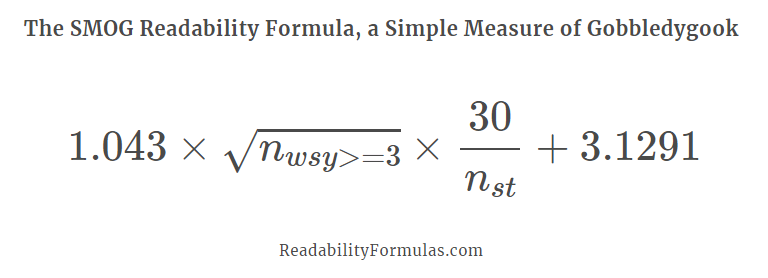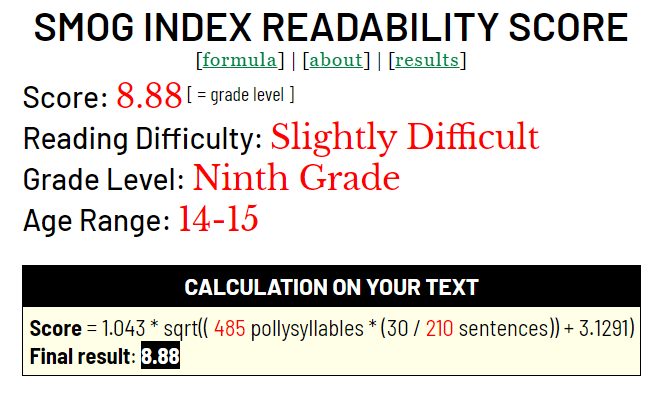G Harry McLaughlin created the SMOG Readability Formula in 1969 through an article, SMOG Grading–A New Readability Formula in the Journal of Reading. SMOG Readability Formula estimates the years of education a person needs to understand a piece of writing. McLaughlin created this formula to improve upon other readability formulas. You may come across SMOG as an acronym for Simple Measure of Gobbledygook, but it’s widely believed the title is a nod to Robert Gunning’s FOG Index. The acronym “gobbledygook” humorously refers to language that is nonsensical or hard to understand.
McLaughlin started his career as a sub-editor of the Mirror newspaper in London, but spent much of his life in Applied Psychology. He left the newspaper to pursue a doctorate in psycholinguistics at the University of London. He wrote a thesis titled, “What Makes Prose Understandable.” After teaching human communications at City University of London, he moved to Toronto, Canada where McLaughlin taught briefly at York University and then to the University of Syracuse, where he published his SMOG Formula in 1969.
The SMOG formula scores a text based on the complexity of its sentences and words. Specifically, it considers the number of polysyllabic words (words with three or more syllables) and the number of sentences in a text.
SMOG Readability Formula
$$ 1.043 \times \sqrt{n_{wsy>=3}} \times \frac{30}{n_{st}} + 3.1291$$
where \(n_{wsy>=3}\) = the number of words with 3 syllables or more.
Step 1: You can score an entire text or random passages.
Step 2: Count 10 sentences in a row near the beginning, 10 in the middle, and 10 in the end for a total of 30 sentences.
Step 3: Count every word with three or more syllables in each group of sentences, even if the same word appears more than once.
Step 4: Calculate the square root of the number arrived at in Step 3 and round it off to nearest 10.
Step 4: Add 3 to the figure arrived at in Step 4 to know the SMOG Grade, i.e., the reading grade that a person must have reached if he is to understand fully the text assessed.
The SMOG Formula is appropriate for secondary age (4th grade to college level) readers.
The calculations of McLaughlin’s SMOG Formula are:
1. A sentence is defined as a string of words punctuated with a period, an exclamation mark, or a question mark.
2. Consider long sentences with a semi-colon as two sentences.
3. Words with hyphens are considered as a single word.
4. Count proper nouns if polysyllabic.
5. Count spelled-out numbers. If in numeric form, determine if they are polysyllabic.
6. Abbreviations should be read as though unabbreviated to determine if they are polysyllabic. However, avoid abbreviations unless commonly known.
7. If the text is shorter than 30 sentences, follow the steps below:
i. Count all the polysyllabic words in the text
ii. Count the number of sentences in the text.
iii. Divide the figures obtained in i. by the figure obtained in ii. to arrive at Average Polysyllabic Words per sentence.
iv. Multiply the figure obtained in iii. with the average number of sentences short of 30.
v. Add the figure obtained in iv. to the total number of polysyllabic words.
vi. Compare the number of polysyllabic words in the SMOG Conversion Table.
| SMOG Conversion Table | |
| Total Polysyllabic Word Count | Approximate Grade Level (+1.5 Grades) |
| 1 – 6 | 5 |
| 7 – 12 | 6 |
| 13 – 20 | 7 |
| 21 – 30 | 8 |
| 31 – 42 | 9 |
| 43 – 56 | 10 |
| 57 – 72 | 11 |
| 73 – 90 | 12 |
| 91 – 110 | 13 |
| 111 – 132 | 14 |
| 133 – 156 | 15 |
| 157 – 182 | 16 |
| 183 – 210 | 17 |
| 211 – 240 | 18 |
McLaughlin validated his formula against the McCall-Crabbs passages. He used a 100% correct-score criterion, whereas most formulas test for around 50%-75% comprehension. His formula predicts scores at least two grades higher than the Dale-Chall formula.
The SMOG Readability Formula offers:
- Accuracy: It’s one of the most accurate measures of readability, correlating highly with comprehension scores on standardized tests.
- Simplicity: The SMOG formula is relatively simple to apply, requiring only basic counting and arithmetic.
- Universality: It can be used for various types of texts, from school textbooks to medical literature.
SMOG is widely used in different fields, including:
- Education: To match reading materials with students’ reading levels.
- Healthcare: To ensure that medical information is accessible to patients.
- Publishing: To tailor content for specific audiences.
Our Readability Scoring System lets you score your text using the SMOG formula.






